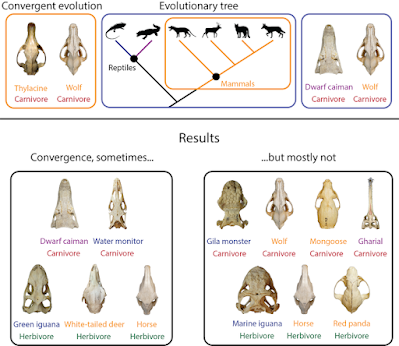Study suggests that most of evolutionary trees could be wrong - The theory of Evolution is just a big unreliable mess
Since Darwin and his contemporaries in the 19th Century, biologists have been trying to reconstruct the “family trees” of animals by carefully examining differences in their anatomy and structure (morphology).
However, with the development of rapid genetic sequencing techniques, biologists are now able to use genetic (molecular) data to help piece together evolutionary relationships for species very quickly and cheaply, often proving that organisms we once thought were closely related actually belong in completely different branches of the tree.
For the first time, scientists at Bath compared evolutionary trees based on morphology with those based on molecular data, and mapped them according to geographical location.
They found that the animals grouped together by molecular trees lived more closely together geographically than the animals grouped using the morphological trees.
Matthew Wills, Professor of Evolutionary Paleobiology at the Milner Centre for Evolution at the University of Bath, said: “It turns out that we’ve got lots of our evolutionary trees wrong.
“For over a hundred years, we’ve been classifying organisms according to how they look and are put together anatomically, but molecular data often tells us a rather different story.
“Our study proves statistically that if you build an evolutionary tree of animals based on their molecular data, it often fits much better with their geographical distribution.
“Where things live – their biogeography – is an important source of evolutionary evidence that was familiar to Darwin and his contemporaries.
“For example, tiny elephant shrews, aardvarks, elephants, golden moles and swimming manatees have all come from the same big branch of mammal evolution - despite the fact that they look completely different from one another (and live in very different ways).
“Molecular trees have put them all together in a group called Afrotheria, so-called because they all come from the African continent, so the group matches the biogeography.”
The study found that convergent evolution – when a characteristic evolves separately in two genetically unrelated groups of organisms – is much more common than biologists previously thought.
Professor Wills said: “We already have lots of famous examples of convergent evolution, such as flight evolving separately in birds, bats and insects, or complex camera eyes evolving separately in squid and humans.
 |
| Source: https://www.eurekalert.org/multimedia/800610 |
“People who make a living as lookalikes aren’t usually related to the celebrity they’re impersonating, and individuals within a family don’t always look similar - it’s the same with evolutionary trees too.
“It proves that evolution just keeps on re-inventing things, coming up with a similar solution each time the problem is encountered in a different branch of the evolutionary tree.
“It means that convergent evolution has been fooling us - even the cleverest evolutionary biologists and anatomists - for over 100 years!”
Dr Jack Oyston, Research Associate and first author of the paper, said: “The idea that biogeography can reflect evolutionary history was a large part of what prompted Darwin to develop his theory of evolution through natural selection, so it's pretty surprising that it hadn't really been considered directly as a way of testing the accuracy of evolutionary trees in this way before now.
“What's most exciting is that we find strong statistical proof of molecular trees fitting better not just in groups like Afrotheria, but across the tree of life in birds, reptiles, insects and plants too.
“It being such a widespread pattern makes it much more potentially useful as a general test of different evolutionary trees, but it also shows just how pervasive convergent evolution has been when it comes to misleading us.”"
- Molecular data produce entirely different evolutionary trees than the traditional Darwinian model.
- Evolution believers can't use homologies = anatomical similarities as evidence for the theory of evolution any more.
- There are several other examples of duelling evolutionary trees produced by molecular data. For example:
https://sciencerefutesevolution.blogspot.com/2017/02/two-different-trees-of-life-darwinian.html
https://creation.com/rogue-data-fell-tree-of-life
https://www.nature.com/articles/s41576-023-00620-x?fbclid=IwAR3_YbHtWpNuxJKZ_Du2yBebYIFQAmWy6MwoOgJRj3_XUyyJUaNeGyAJTv0 - There is not a single biologically reliable evolutionary tree, they all are based on human imagination.
- The theory of convergent evolution in parallel branches of any tree supports Creation orchard, not Darwinian evolution.
- The theory of evolution has failed.




